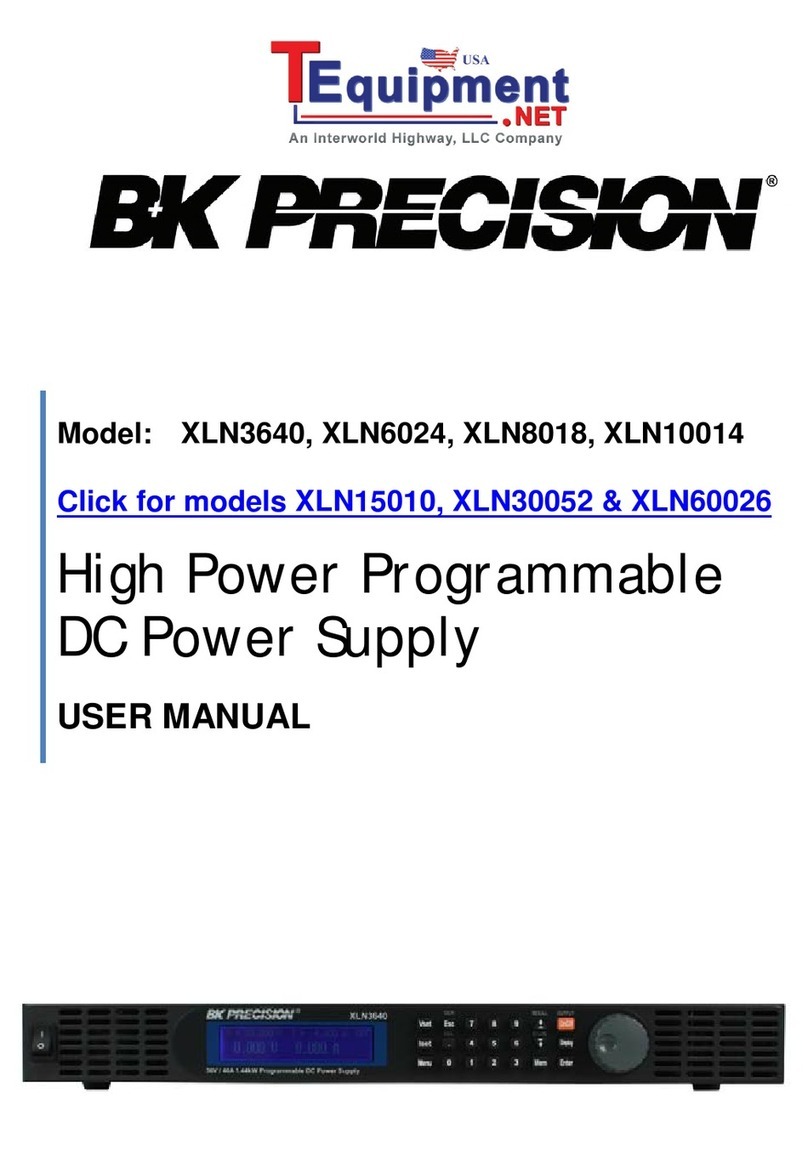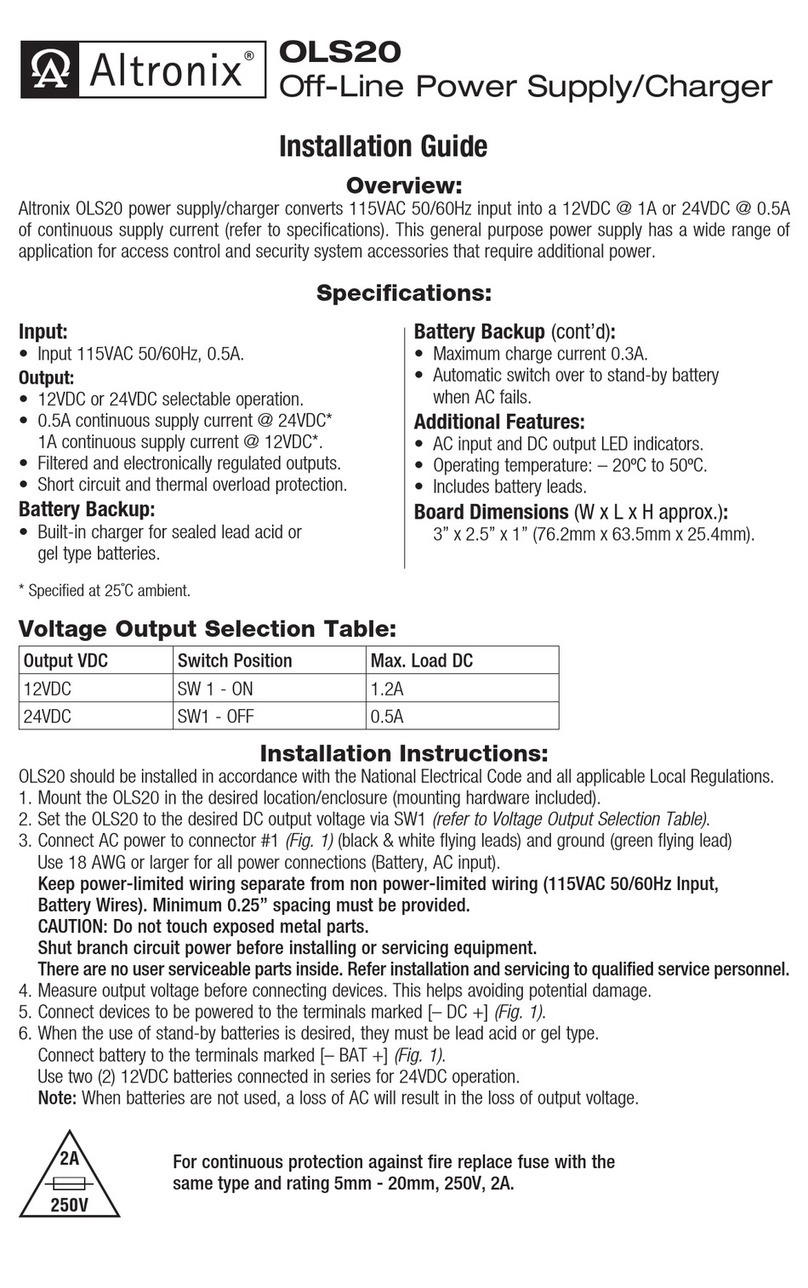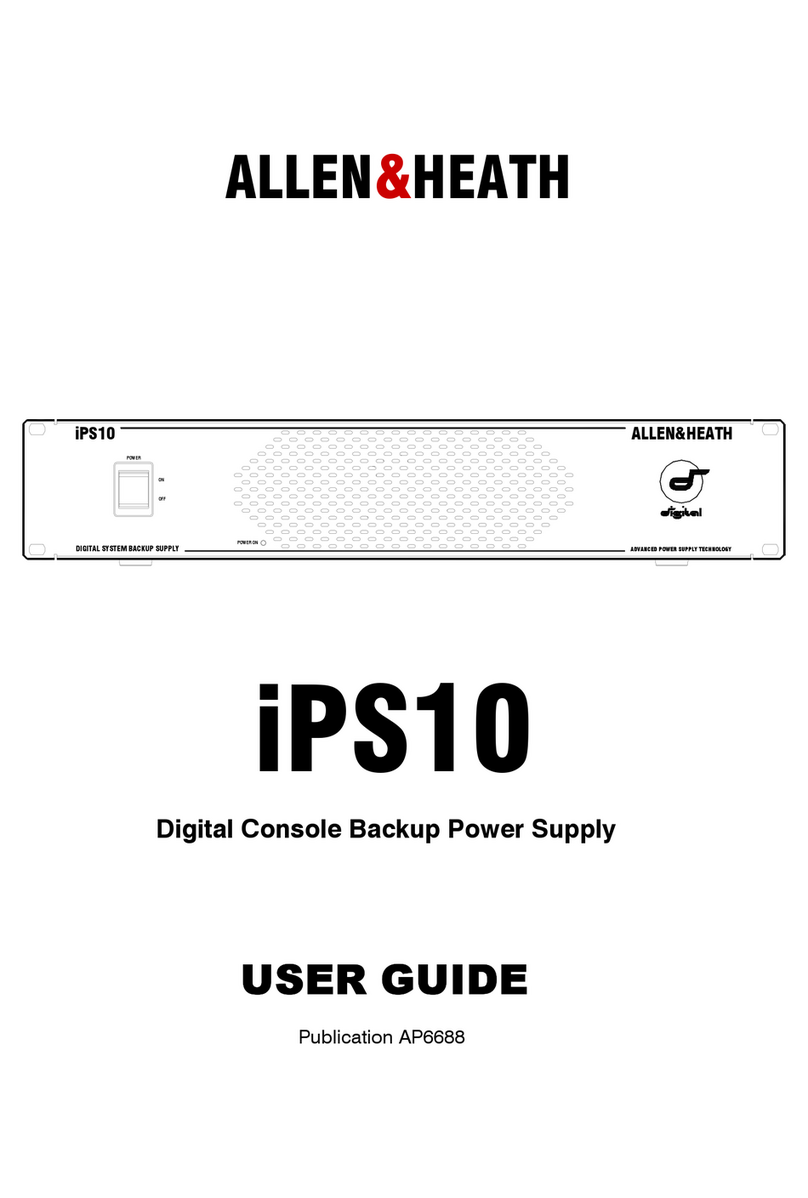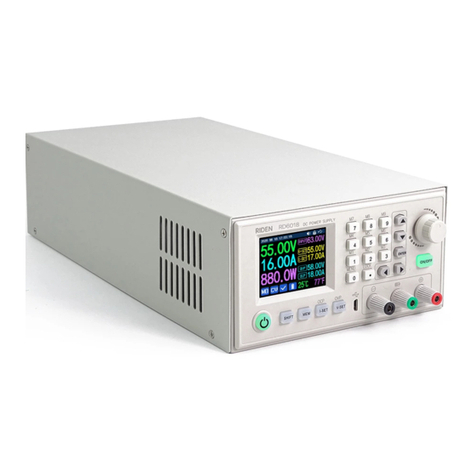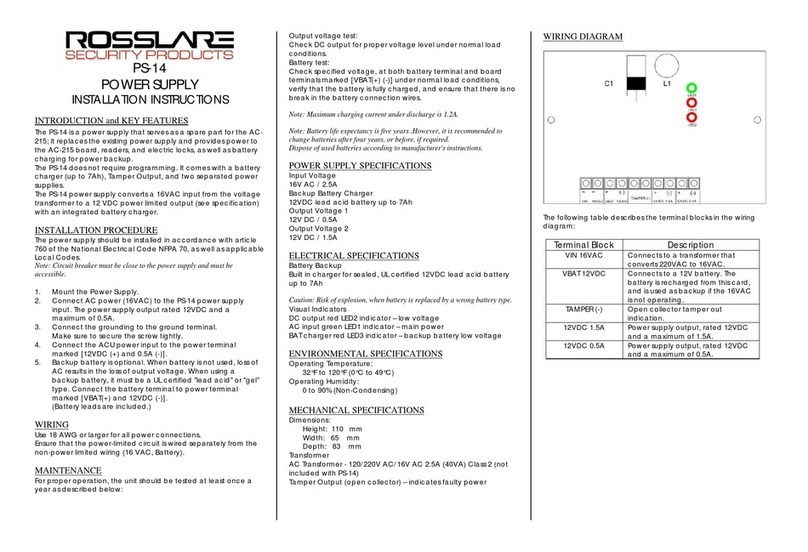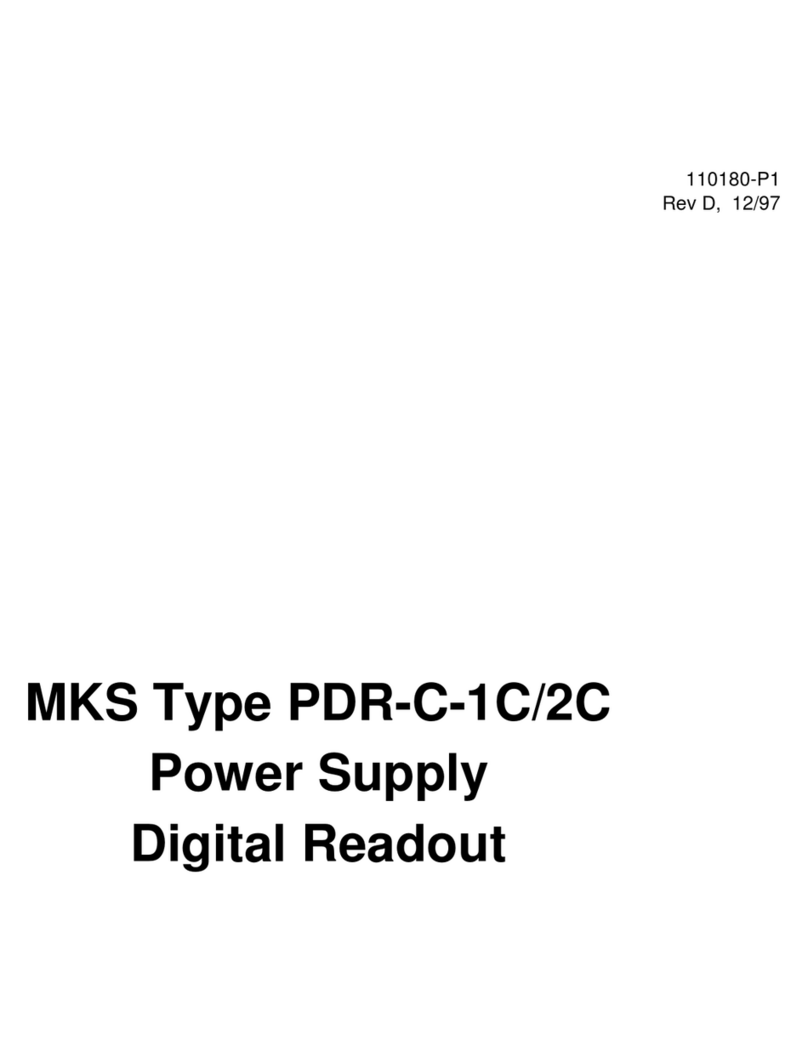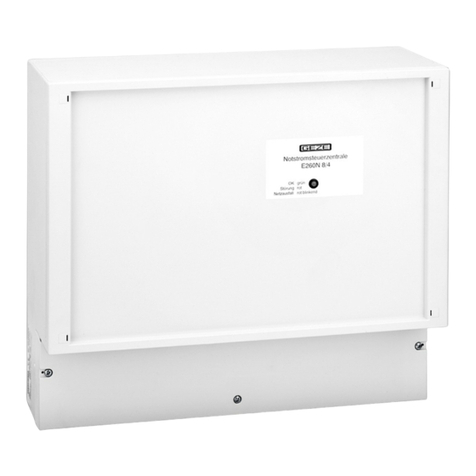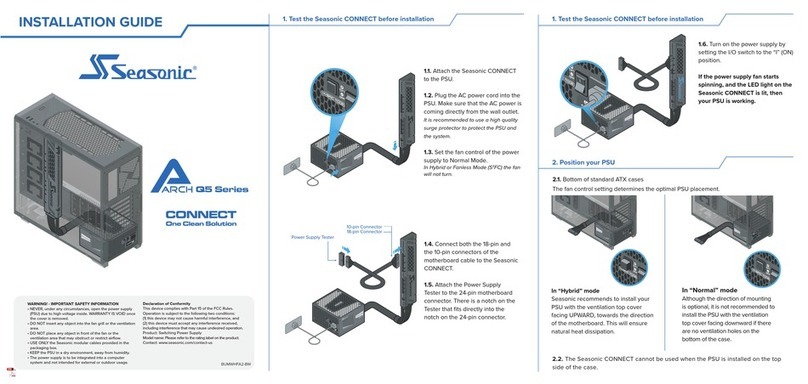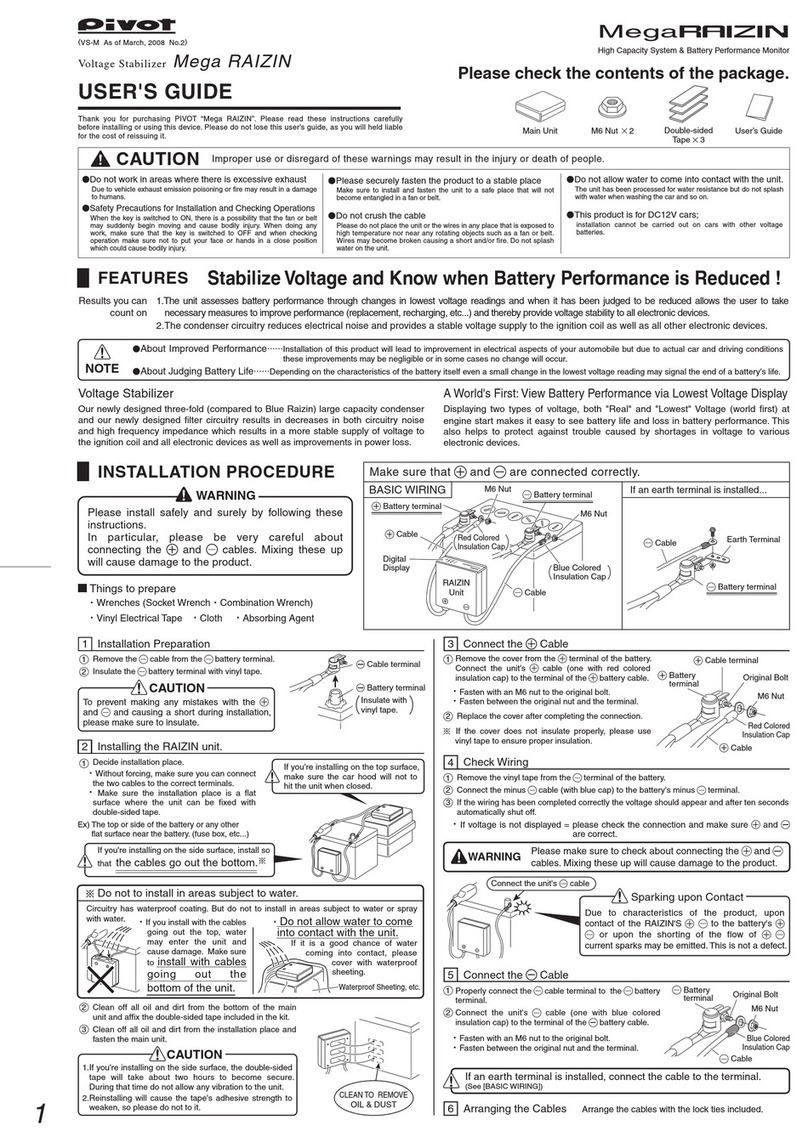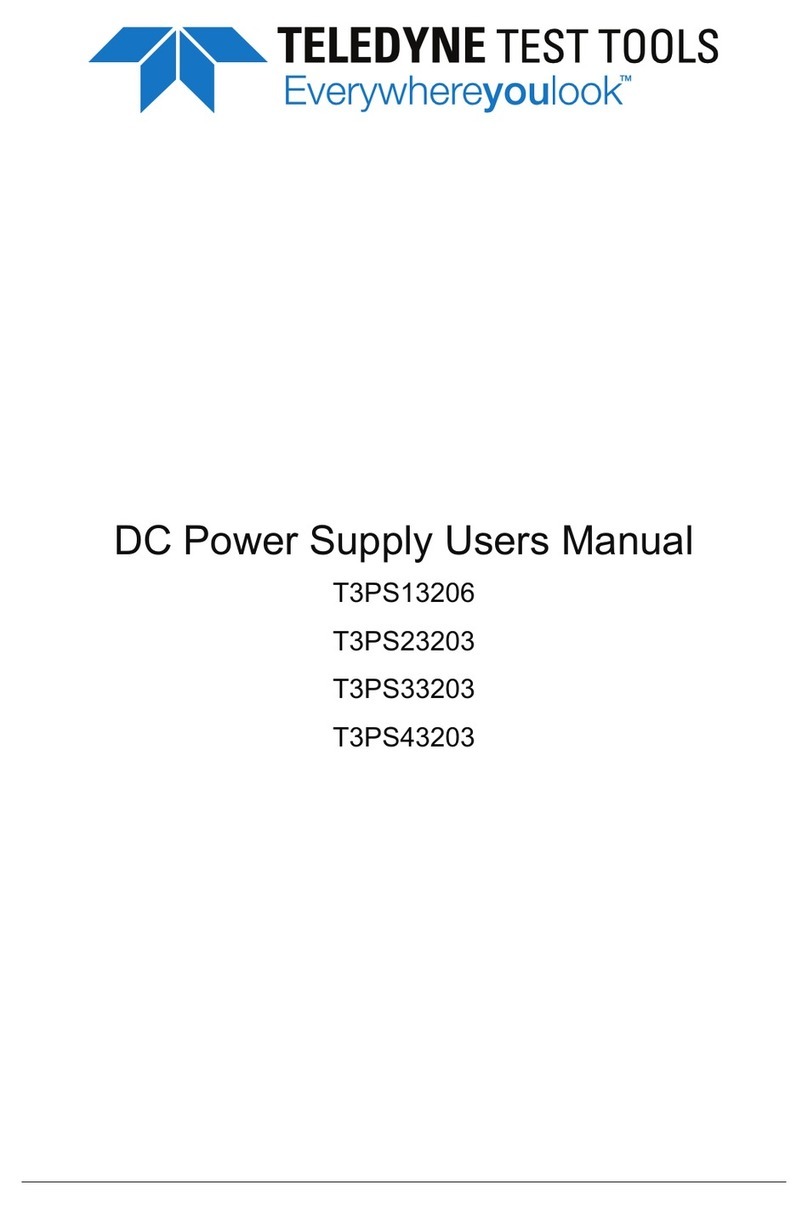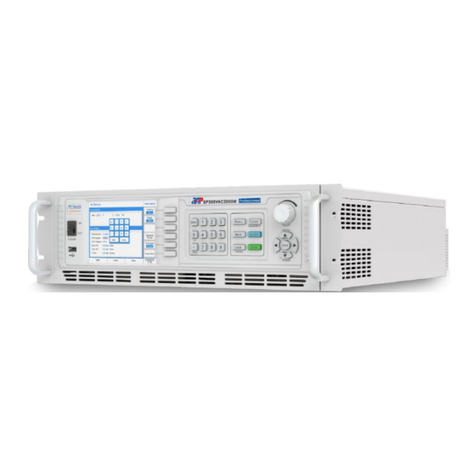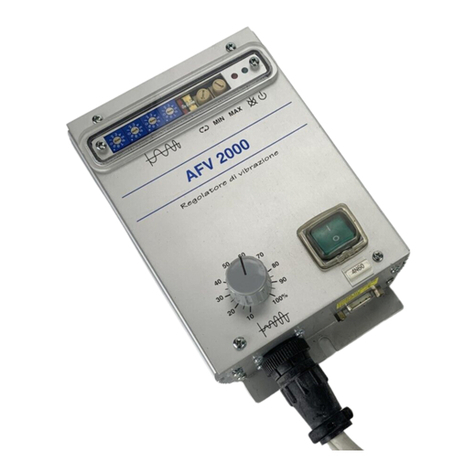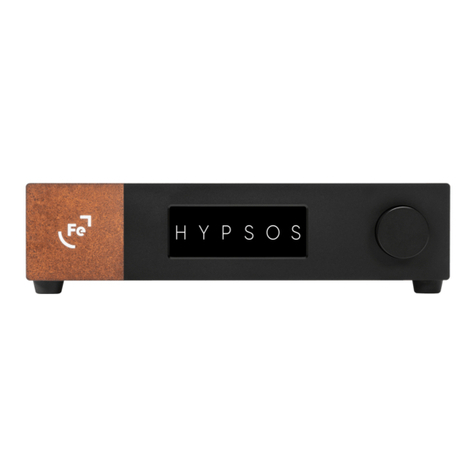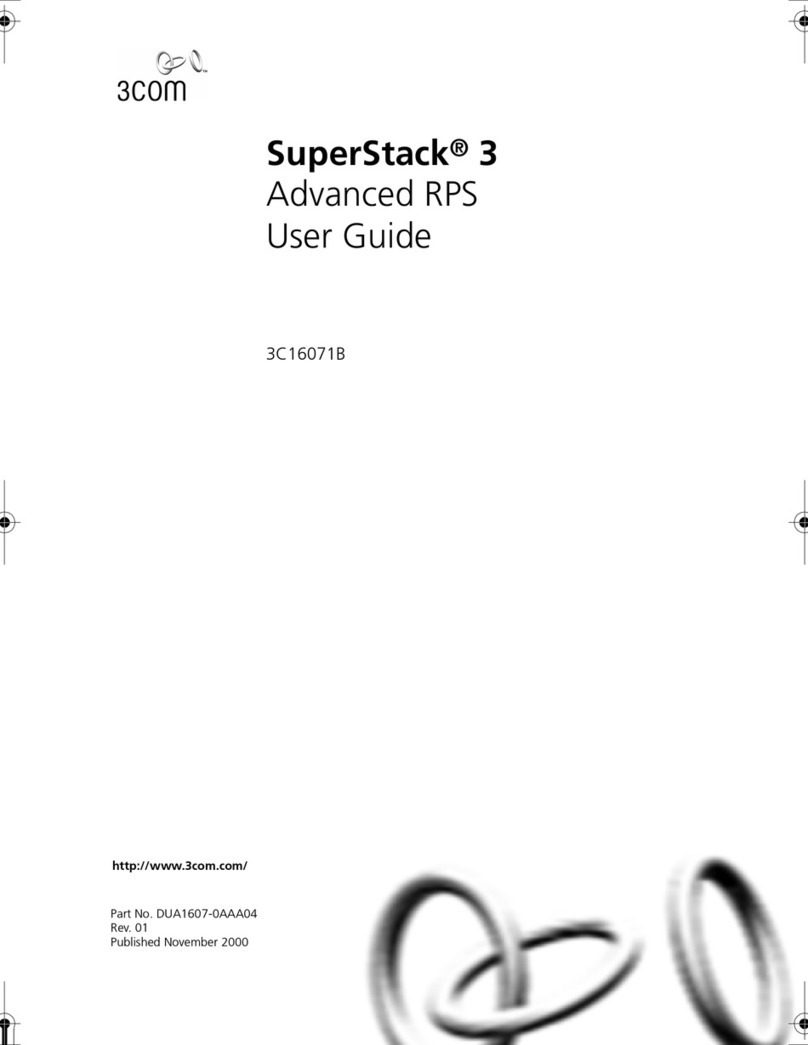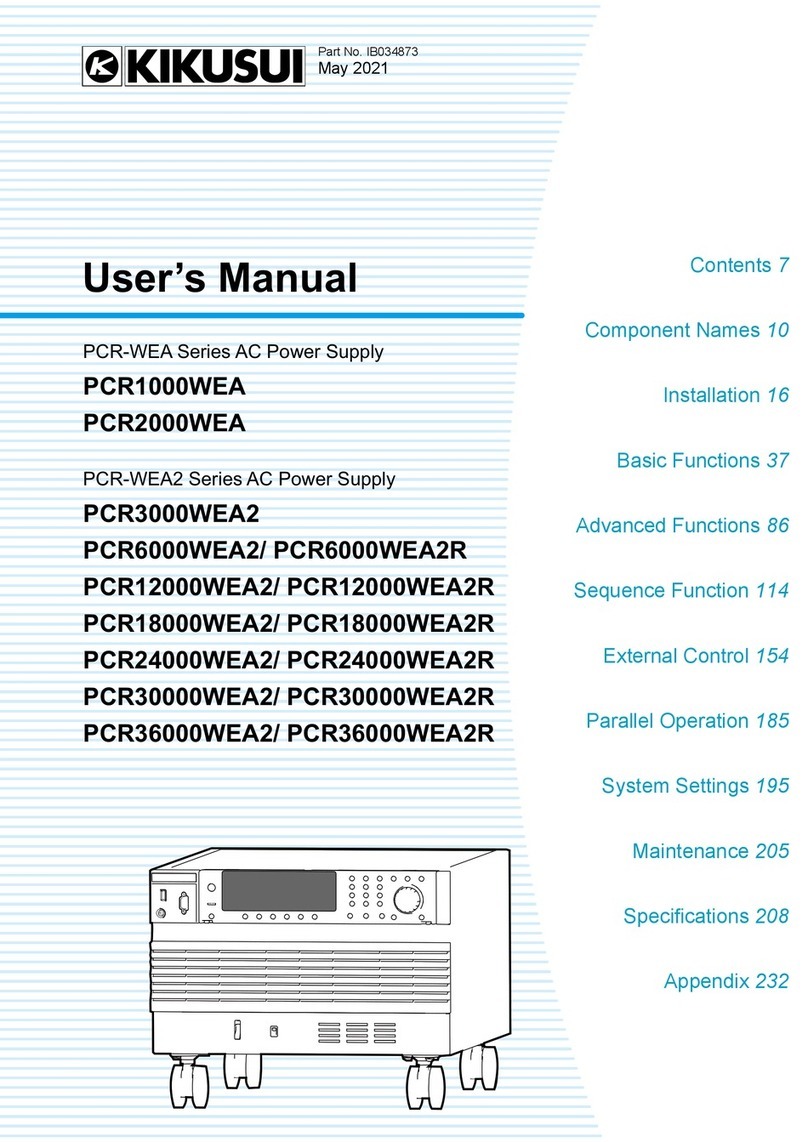Tequipment PSP-603 User manual

PSP SERIES USER MANUAL
i
CONTENTS PAGE
1. Product Introduction…………..........................................…... 1
2. Safety Information……………………….……………….…... 3
3. Technical Specification………….…………………………….. 7
4. Panel Controls and Indicator………………………….…..…. 9
5. Functional Description of Operation Element……...……….. 12
6. Operating Instruction with Keypad Input............................... 13
7. Disposal......…………………………………………………….. 17
8. Rectification of Faults………….……………………………… 18
9. Maintenance..........……….……………………………………. 19
10.APPENDIX: Connectin
g
the Pro
g
rammable Power Suppl
y
via RS232 Interface..................................................................... 21
PSP SERIES USER MANUAL
ii
Declaration of Conformity
We
GOOD WILL INSTRUMENT CO., LTD.
No. 7-1, Jhongsing Rd., Tucheng City, Taipei County 236, Taiwan.
declares that the below mentioned product
PSP-603, PSP-405, PSP-2010
Are herewith confirmed to comply with the requirements set out in the Council
Directive on the Approximation of the Law of Member States relating to
Electromagnetic Compatibility (89/336/EEC, 92/31/EEC, 93/68/EEC) and Low
Voltage Equipment Directive (73/23/EEC, 93/68/EEC). For the evaluation regarding
the Electromagnetic Compatibility and Low Voltage Equipment Directive, the
following standards were applied:
◎EMC
EN 61326-1: Electrical equipment for measurement, control and laboratory use ––
EMC requirements (1997+A1: 1998)
Conducted and Radiated Emissions
EN 55011: 1998 Electrostatic Discharge
EN 61000-4-2: 1995+A1:1998
Current Harmonic
EN 61000-3-2: 1995+A1: 1998+A2: 1998 Radiated Immunity
EN 61000-4-3: 1996
Voltage Fluctuation
EN 61000-3-3: 1995 Electrical Fast Transients
EN 61000-4-4: 1995
------------------------- Surge Immunity
EN 61000-4-5: 1995
------------------------- Conducted Susceptibility
EN 61000-4-6: 1996
------------------------- P.F.Magnetic Field
EN 61000-4-8: 1993
------------------------- Voltage Dips/ Interrupts
EN 61000-4-11: 1994
◎Safety
Low Voltage Equipment Directive 73/23/EEC & amended by 93/68/EEC
IEC/EN 61010-1: 2001
EN 60950 :1992+A1:1993+A2 :1993+A3 :1995+A4 : 1997+A11: 1997
IEC 60950:1991+A1:1992+A2 :1993+A3 :1995+A4 : 1996

PSP SERIES USER MANUAL
iii
SAFETY TERMS AND SYMBOLS
These terms may appear in this manual or on the product:
WARNING. Warning statements identify condition or
practices that could result in injury or loss of life.
CAUTION. Caution statements identify conditions or
practices that could result in damage to this product or
other property.
The following symbols may appear in this manual or on the
product:
DANGER ATTENTION Protective Earth (ground) Frame or
High Voltage refer to Manual Conductor Terminal Chassis
Terminal Terminal
PSP SERIES USER MANUAL
iv
FOR UNITED KINGDOM ONLY
NOTE: This lead/appliance must only be wired by competent
persons
WARNING: THIS APPLIANCE MUST BE EARTHED
IMPORTANT: The wires in this lead are coloured in accordance
with the following code:
Green/ Yellow: Earth
Blue: Neutral
Brown: Live (Phase)
As the colours of the wires in main leads may not correspond with
the colours marking identified in your plug/appliance, proceed as
follows:
The wire which is coloured Green & Yellow must be connected to
the Earth terminal marked with the letter E or by the earth
symbol or coloured Green or Green & Yellow.
The wire which is coloured Blue must be connected to the
terminal which is marked with the letter N or coloured Blue or
Black.

PSP SERIES USER MANUAL
v
The wire which is coloured Brown must be connected to the
terminal marked with the letter Lor Por coloured Brown or Red.
If in doubt, consult the instructions provided with the equipment
or contact the supplier.
This cable/appliance should be protected by a suitably rated and
approved HBC mains fuse: refer to the rating information on the
equipment and/or user instructions for details.As a guide, cable of
0.75mm2should be protected by a 3A or 5A fuse. Larger
conductors would normally require 13A types, depending on the
connection method used.
Any moulded mains connector that requires removal /replacement
must be destroyed by removal of any fuse & fuse carrier and
disposed of immediately, as a plug with bared wires is hazardous if
a engaged in live socket. Any re-wiring must be carried out in
accordance with the information detailed on this label.
PSP SERIES USER MANUAL
1
1. Product Introduction
The PSP series is a programmable switching power supply with backlit
liquid crystal display built to the latest technological standards.
Construction is in accordance with VDE 0411 = EN 61010. Moreover, the
PSP series has been EMV-tested and fulfils the requirements of the
applicable European and national directives. Conformance to these has
been proven; the relevant statements and documents are lodged with the
manufacturer.
Note: This is a Class A device which can cause RF
interference within the home.
To maintain this condition and to guarantee safe operation, the user
must observe these operating instructions without fail.
Application Note
zConnection of low-voltage loads to the marked connection sockets
provided for this purpose and their operation at a voltage between 0 to
rating voltage.
zThe current consumption of a connected load may not exceed rating
current.
zThe Switching Power Supply PSP series is suitable for connection to
115 or 230 V 50/60 Hz AC power sockets.
zOperation must not take place under unfavorable ambient conditions
including:
-Moisture or excessive air humidity.
-Dust and combustible gases, fumes or solvents.

PSP SERIES USER MANUAL
2
-Thunderstorms or storm conditions such as strong electrostatic fields,
etc.
Any use other than above description may leads to damage to the unit;
or causes dangers such as short circuit, fire, electric shock, etc. No part
of the product may be modified or converted. The safety instructions are
to be followed without fail.
PSP SERIES USER MANUAL
3
2. Safety Information
Note: Damage caused by failure to observe the operating
instructions voids the guarantee.
We accept no liability for consequential damage and accept no responsibility
for damage to property or injury to persons caused by improper operation
or failure to observe the safety instructions. Such cases void the guarantee.
a) Installation and handling safety instructions
Observe the following rules when installing the instrument:
a1. Avoid use the instrument in extremely cold or hot locations or
directly adjacent to a heating fan.
a2. Never switch the instrument on immediately when it is brought
from a cold environment into a warm room until the instrument
comes to room temperature as under the adverse conditions, the
resultant condensation may destroy the instrument.
a3. Ensure there is proper ventilation for the vents in the case (front left
side and cooling fan on the rear) to prevent heat build-up from
damaging the instrument.
a4. Never operate the instrument near hot soldering irons.
a5. Do not place the Power Supply with its front panel down to avoid
damaging the operating controls.
b) General safety requirements
The Switching Power Supply PSP series has been fully inspected and
tested with technically safe condition before shipping from the factory.
To maintain this condition and to ensure safe operation, it is essential
for the user to observe the safety instructions and warning notes which

PSP SERIES USER MANUAL
4
are contained in this user manual.
The instrument is constructed to Protection Class I. It is equipped with
a VDE-approved power supply with safety cable and may only be used
with and connected to AC supplies with safety earthing.
Ensure that the (yellow/green) earthed wire in the instrument, in its
power cable and in the AC supply remains sound, because a damaged
earth wire can endanger life.
In commercial facilities the accident-prevention regulations of the
industrial employers' liability association for electrical systems and
equipment must be observed.
In schools, training facilities, hobby and self-help workshops, the
operation of power supplies and accessories must be supervised by the
trained personnel.
Make sure that only the fuses of the given types and nominal current
ratings are used as replacements. The use of repaired fuses or the
bridging of fuse holders is not permitted. A small flat-bladed
screwdriver is required to change the AC fuse. Carefully lever up the
cover in the AC power socket and withdraw it. Remove the defective
fuse and replace it with an intact one of the same type and nominal
current rating. Afterwards replace the fuse cover.
The measuring instrument is operated only when the case is securely
closed and screwed up.
PSP SERIES USER MANUAL
5
While proceeding the operation of power supplies, the wearing of
metal or other conducting jewelry such as chains, bracelets, rings, etc.
is not recommended.
Note: Power supplies are not intended for use with/on
people or animals.
When connecting the outputs of more than one power supply in series
voltages may danger to life (> 35 VDC). Only power supplies with an
identical output (current and voltage) specification may be placed in
series or in parallel, otherwise the weaker of the two will be damaged.
The instrument is to be placed onto a hard, non-inflammable base, so
that cooling air can enter unhindered. The cooling of the unit occurs
predominantly through convection.
Note: Power supply ventilation holes should not be
covered.
Power supplies and their connected loads should not be left operating
unsupervised. There are measures for the protection and safety of
connected loads in the face of power supply incidents (e.g.
overvoltages, complete failure) and effects and dangers stemming
from the loads themselves (e.g. unduly-high current consumption).
Faulty power supplies can produce voltages over 50 V DC, which can
be dangerous even when the indicated normal output voltages of the
units are lower than this.
Note: For power-on work, only tools expressly intended
for this should be used.

PSP SERIES USER MANUAL
6
The power supply outputs and connecting leads, sockets and terminals
must be protected from being touched directly. In addition, the leads
used must be sufficiently insulated and voltage-proof and the contact
points safe from being touched (safety sockets).
Use of bare metal leads and contacts should be avoided. All such items
are to be covered by suitable, nonflammable insulating material or
other measures taken and therefore protected from being touched
directly. The electrically conducting parts of the connected load must
also be appropriately protected from being touched directly.
If the instrument is assumed that safe operation is no longer possible
according to the following phenomena, then the unit must be switched
off and protected against unintentional operation:
- the unit shows visible signs of damage,
- the unit no longer functions and
- after prolonged storage under unfavourable conditions or
- after severe transportation stress.
Do switch on the switched power supply immediately when it has been
brought from a cold environment into a warm room until it comes to
room temperature as under adverse conditions, the resultant
condensation can destroy the unit.
PSP SERIES USER MANUAL
7
3. Technical Specifications
Model PSP-603 PSP-405 PSP-2010
Operating voltage 115/230 VAC ±15%
Power frequency 50/60 Hz
Power consumption approx. 420VA max.
Power output 200W max.
Output voltage 0~60VDC, 20mV
resolution 0~40VDC,
10mV resolution 0~20VDC, 10mV
resolution
Program Accuracy ±0.05%±4 digits ±0.05%±3 digits ±0.05%±3 digits
Output Current 0~3.5A
2mA resolution 0~5A
2mA resolution 0~10A
5mA resolution
Program Accuracy ±0.1%±5 digits ±0.1%±5 digits ±0.3%±10 digits
Voltage Load Regulation ≦10 mV
Current Load Regulation ≦5 mA
Voltage Line Regulation. ≦0.05%
Current Line Regulation ≦0.05%
Ripple Voltage ≦20 mV rms
Ripple Current ≦10 mArms
Readback Resolution
(Meter) 20mV 2mA 10mV 2mA 10mV 5mA
Rise Time ≦150ms (≦95% rating load)Response
Time Fall Time ≦150ms (≧10% rating load)
Recovery Time 30ms (50% Load Change, Minimum load 0.5A)
Readback Accuracy (Meter)
Voltage ±0.05%±4 digits ±0.05%±3 digits ±0.05%±3 digits
Current ±0.1%±5 digits ±0.1%±5 digits ±0.3%±10 digits
Digital Display Multi-line LCD with background lighting
AC fuse Slow-blow T6.3A/250V for 115V, T3.15A/250V for 230V
Command Process Time 250ms
Interface (Standard) RS-232C
Weight Approx. 4 kgs
Dimensions
(W ×H ×L) Approx. 225×100×305 m/m
(without stand and power cable)

PSP SERIES USER MANUAL
8
Environmental Conditions
Operating
Environment Indoor use, altitude up to 2000m.
Ambient Temperature 0℃to 40℃.
Relative Humidity 80%(Maximum).
Installation category II
Pollution Degree 2
Operating temperature &
Humidity 0°C to +40°C
80% (Maximum), non-condensing
Storage temperature range -10°C to +70°C
Accessories Power cord….............……….. 1
Instruction manual…………… 1
Test Lead……….……………. 1
PSP SERIES USER MANUAL
9
4. Panel Controls & Indicator
Front Panel
1) 4 mm safety sockets: 1a negative connection "-", 1b positive
connection "+" and 1c earth connection.
2) "POWER" AC switch for switching the power supply on ("1") and
off ("0").
3) Encoder wheel for changing the V SET, V LIMIT, I LIMIT, P
LIMIT, +%, and -% parameter settings.
4) Keypad for actual operation of the Switching Power Supply PSP
series. The exact description follows below.
5) Backlit LCD Display with indication of the output voltage, current,
power settings and indication of the V, I and P limits. Additionally,
indication of OUTPUT On or Off and keypad locked or unlocked.
Rear Panel
6) AC rear power socket.
7) RS-232 interface (with optocoupler) for connection to PC.
8) Cooling fan.

PSP SERIES USER MANUAL
10
zFront Panel
Figure 4-1
PSP SERIES USER MANUAL
11
zRear Panel
Figure 4-2

PSP SERIES USER MANUAL
12
5. Functional Description of Operating Elements
With its continuously adjustable voltage and current settings, this
power supply can be used universally in school, work, hobby, and other
applications. An electronic current limiter protects the power supply from
overload and short-circuits at its output; a fan controlled by a temperature
circuit protects the power supply (its electronics) from thermal overload.
During such an overload (short circuit or overload) the output is
regulated down, i.e. the voltage is reduced. Only when the short-circuit
has been remedied is the output released.
The set values can be read via the illuminated multiple-line LCD
display. The voltage, current or power setting is adjusted by means of an
encoder wheel in 10mV, 20mV, 1mA, 2mA, 10mA and 1 W steps
respectively. Therefore the exact adjustment of the output voltage and the
current limit and maximum output power is possible. However, observe
the safety hints without fail.
PSP SERIES USER MANUAL
13
6. Operating Instructions with keypad input
A)Basic setting
a) Connect the AC power cable to the AC power socket and ensure
that it is firmly seated. Then plug the earthed power plug into an
earthed AC power socket.
Attention: The continuity of the safety earth wire must be
unbroken within the instrument, within the AC power
cable and within the AC power socket otherwise life will
be endangered.
b) Press the AC power On/Off switch
Attention: The earth connector in the front of the
instrument and the RS-232 interface connector earth are
connected directly with the earthing wire of the AC power
input socket and of the connected AC power socket.
Before operating the instrument each time, first check and
ensure that the 4 mm sockets of the instrument is well fit of
no damage.
B) Setting the limits
The voltage, current and power output values are each limited to a
maximum. This upper limit can be varied downwards. Setting the limits
is carried out using the “V LIMIT” “I LIMIT” “P LIMIT” keys as
follows:
V LIMIT Voltage limit
Press the "V LIMIT" key in the "LIMITS" field until
the symbol "U-const" flashes. The voltage limit can now
be adjusted to 1V steps by using the encoder wheel. If

PSP SERIES USER MANUAL
14
the "V LIMIT " key is now pressed for longer than 2s,
the voltage upper limit will again be set at "rating
voltage". To complete the input, press the "ENTER"
key. An inadvertently wrong-set limit setting can be
erased/reset with the " CE " key. As a result of this, the
previous set value will be indicated and the setting
menu exited. The "U-const" will no longer flash.
During operation (output On), the voltage output can
also be adjusted up to the set limit.
I LIMIT Current limit
Press the " I LIMIT" key in the "LIMITS" field until the
symbol "I-const" flashes. The current limit can now be
adjusted to 1mA, 2mA, 10mA ("fine") or 100mA
("norm", coarse) steps by using the encoder wheel. If
the "I LIMIT" key is now pressed for longer than 2s, the
current upper limit will again be set at "rating current".
To complete the input, press the "ENTER" key. An
inadvertently wrong-set limit setting can be erased/reset
with the " CE " key. As a result of this, the previous set
value will be indicated and the setting menu exited. The
"I-const" will no longer flash.
P LIMIT Power limit
Press the "P LIMIT" key in the "LIMITS" field until the
symbol "P-const" flashes. The power limit can now be
adjusted to 1 W steps by using the encoder wheel. If the
"P LIMIT" key is now pressed for longer than 2s, the
PSP SERIES USER MANUAL
15
power upper limit will again be set at "200 W". To
complete the input, press the "ENTER" key. An
inadvertently wrong-set limit setting can be erased/reset
with the " CE " key. As a result of this, the previous set
value will be indicated and the setting menu exited. The
"P-const" will no longer flash.
Attention: The current "I LIMIT" is adjusted
independently of its setting by the maximum output
power setting. The voltage upper limit does not
change.
C)"KEY INPUT" field settings
V SET Using the "V SET" key, the output voltage can be adjusted
up to the preset upper limit directly. For this the "V SET"
key must be pressed and held and the voltage changed
with the encoder wheel. If the "fine" F key is selected,
the changes occur in 10 mV, and 20mV steps. If
"norm" N key is selected, the changes occur in 1V
steps.
ENTER Each input via the "LIMITS" keypad is completed with the
"ENTER" key.
CE Any values incorrectly entered via the "LIMITS" keypad
can be reset with the " CE " key.
N The size of each setting step can be changed by using the
" N " ("Normal") key. In connection with the " F " key, so-
called mutual locking is achieved.
F If the " N " key is pressed, the "fine" symbol disappears

PSP SERIES USER MANUAL
16
from the display. If the " F " key is pressed, the symbol "fine"
appears on the display.
LOCK Pressing the "LOCK" key locks/blocks all keys and the
encoder wheel against inadvertent adjustment. Only the
"Power" switch remains active. Locking is indicated by the
"locked" symbol in the bottom line of the display. If the
"LOCK" key is pressed again (> approx. 2s), then the
operating elements are released again (unlocked).
D) Adjusting the output
OUTPUT The output of the power supply is switched on or off via
a relay with the "OUTPUT" key. In the process, the
status "On" or "Off" is indicated at the bottom right of
the display. On switching the power supply on, the
output is always in switched-off status.
E) +%, -% settings
+% Under output off status, press +% key once, the LCD display
will indicate xxx (the multiple value of the original storage
data), now set the +% value by using the knob and press enter
key to save it. Afterward, when the output is in the “ON”
status, press +% key, the output will be changed according to
the saved multiple value.
-% Under output off status, press -% key once, the LCD display
will indicate xxx (the multiple value of the original storage
data), now set the -% value by using the knob and press enter
key to save it. Afterward, when the output is in the “ON”
status, press -% key, the output will be changed according to
PSP SERIES USER MANUAL
17
the saved multiple value.
For example:
Set the output voltage as 10.00V, the save value of +% is 105,
and the save value of -% is 95. The +% key is pressed, output
voltage will be changed to 10.00V ×1.05 = 10.50V, while the -
% key is pressed, output voltage will be changed to 10.00V ×
0.95 = 9.50V. The output voltage will be back to normal by
pressing the normal key.
F) "REM" key
A serial RS-232 interface is incorporated on the rear of the case.
With the appropriate interface cable and optional software,
communication with an IBM-compatible PC is therefore possible.
The interface is naturally via an optocoupler.
REM Clear the Remote Control mode and use panel control setting
instead. Thereupon, as with "LOCK", all operating elements
(except POWER) are locked against direct input.
7. Disposal
Dispose of an unusable, irreparable Switching Power Supply PSP
series in accordance with applicable statutory regulations.

PSP SERIES USER MANUAL
18
8. Rectification of faults
With the PSP series power supply you have acquired a new generation
measuring instrument constructed to the latest technological standards.
However, faults can occur. Because of this, the following describes
how some of these problems can be resolved by the user relatively
easily:
Problem Possible solution
No display Is the instrument switched on?
Is the AC power plug making good contact
both in the instrument and in the AC power
socket?
Is the AC fuse OK?
No input possible "REM" or "LOCK" key pressed; see under
section C or F
Attention: Except when this is possible manually, the opening
of covers or removal of parts can expose voltage-carrying
components. Connection points may also be live. Before any
adjustment, maintenance, repair or exchange of parts or
assemblies requiring opening of the unit, the unit must be
disconnected from all voltage sources and measurement
circuits. If the adjustment maintenance or repair is
subsequently required for the open unit, these must only be
performed by a specialist familiar with the associated
hazards and relevant regulations (VDE-0100, VDE-0701,
VDE0683).
Capacitors within t he instrument can remain charged
even when the unit has been disconnected from all voltage
sources and measurement circuits.
PSP SERIES USER MANUAL
19
9. Maintenance
The following instructions are executed by qualified personnel only. To avoid
electrical shock, do not perform any servicing other than the operating instructions
unless you are qualified to do so.
9-1.Fuse Replacement
If the fuse blown, the CV or CC indicators will not light and the
power supply will not operate. The fuse should not normally blow
unless a problem has developed in the unit. Try to determine and
correct cause of the blown fuse, then replace only with a fuse of the
correct rating and type. The fuse is located on the rear panel (see Fig.
4-2).
WARNING: For continued fire protection. Replace with
250V fuse of the specified type and rating, and disconnect
the power cord before replacing fuse.
9-2.Line Voltage conversion
The primary winding of the power transformer is tapped to permit
operation from 115/230 VAC, 50/60 Hz line voltage. Conversion from
one line voltage to another is done by change AC selects switch as
shown in Fig. 4-2.
To convert to different line voltage, perform the following procedure:
(1) Make sure the power cord is unplugged.
(2) Set the AC switch to the desired line voltage position.

PSP SERIES USER MANUAL
20
9-3. Cleaning
To clean the power supply, use a soft cloth dampened in a solution
of mild detergent and water. Do not spray cleaner directly onto
the instrument, since it may leak into the cabinet and cause
damage. Do not use chemicals containing benzine, benzene,
toluene, xylene, acetone, or similar solvents. Do not use abrasive
cleaners on any portion of the instrument.
9-4. Fan Control
1) The fan of the power supply will not work upon power on
until the temperature or load current reaches the condition as
follows:
zTemperature oriented:
When the temperature of the power supply reaches to range
of 45℃±5℃for 5 to 6 seconds, the fan starts to work,
while the temperature is less than 40℃±5℃, the fan stops
rolling.
zLoad current oriented:
The load current varies with different model of power supplies.
After the load current reaches to the value as shown below, the
fan will keep on rolling.
Model Load Current Fan Load Curren
t
Fan
PSP-405 2.10A±50mA On 1.80A±50mA Off
PSP-603 1.40A±50mA On 1.20A±50mA Off
PSP-2010 2.10A±50mA On 1.80A±50mA Off
2) To avoid damaging the power supply, if the fan failed to work
when the temperature or current has reached to the specific
condition, please power off the instrument and contact our local
distributor for service.
PSP SERIES USER MANUAL
21
10. APPENDIX: Connecting the Programmable Power
Supply via RS232 Interface
The RS232 interface capabilities:
The RS232 interface provides a point-to-point connection between two
items of equipment such as a computer and the power supply. There
are some parameters you need to set on the both sides. Once you have
set these parameters, you can control the power supply through the
RS232 interface.
zBaud rate: 2400 baud.
zParity bit: none.
zData bit: 8 bits.
zStop bit: 1 stop bit.
zData flow control: none.
Notes for RS232 installation
The power supply is a DTE device with a 9-pin D-type shell RS232
connector located on the rear panel. Figure 1 shows the equipment of
9-pin connector (Male) with its pin number assignments. Figure 2
shows the wiring configuration for DB9 to DB9. When the
programmable power supply is set up with a RS232 interface, please
check the following points:
zDo not connect the output line of one DTE device to the output
line of the other.
zMany devices require a constant high signal on one or more input
pins.
zEnsure that the signal ground of the equipment is connected to
the signal ground of the external device.
zEnsure that the chassis ground of the equipment is connected to
the chassis ground of the external device.
zDo not use more than 15m of cable to connect devices to a PC.
zEnsure the same baud rate is used on the device as the one used
on PC terminal.
zEnsure the connector for the both side of cable and the internal
connected line are met the demand of the instrument.

PSP SERIES USER MANUAL
22
1. No connection
2. Receive Data(RxD) (input)
3. Transmit Data(TxD) (output)
4. +12V Input(*) (input)
5. Signal Ground(GND)
6. No connection
7. No connection
8. No connection
9. No connection
*Note: This pin needs a constant high signal (+12V).
Figure 1 Pin assignments of the RS232 connector on the rear panel for DB-9-D
Figure 2 Wiring configuration for DB9 to DB9
Computer’s Connection
A personal computer with a COM port is the essential facilities in
order to operate the programmable power supply via RS232 interface.
The connections between power supply and computer are as follows:
I. Connect one end of a RS232 cable to the computer.
II. Connect the other end of the cable to the RS232 port on the
programmable power supply.
III. Turn on the programmable power supply.
IV. Turn on the computer.
EQUIPMENT COMPUTER
(DB9, DTE) (DB9, DTE)
Pin 2 Pin 2
Pin 3 Pin 3
Pin 4 Pin 4
Pin 5 Pin 5
PSP SERIES USER MANUAL
23
RS232 message terminator
The power supply has 25 commands available. Every command is end
up with <cr> (ASCII 0Dh or ACSCII 0D 0A acceptable). The return
message <cr>of the power supply is CR/LF (ASCII 0D 0A).
*L
Function:
To obtain all the status values of the power supply.
Syntax:
L<cr> HEX = 4C 0D
Explain:
When the message L<cr>is sent to the power supply from computer,
the power supply will return the message as follows immediately:
Vvv.vvAa.aaaWwww.wUuuIi.iiPpppFffffff<cr> 37 characters
totally
The contents consist of the uppercase V,A,W,U,I,P,F, the numeral
from 0 to 9 and decimal. Further details is described as follows:
vv.vv = The present output voltage, the unit: V.
a.aaa = The present output current, the unit: A.
www.w = The present output load, the unit: W.
uu = The maximum voltage limit at present, the unit: V.
i.ii = The maximum current limit at present, the unit: A.
ppp = The maximum load limit at present, the unit: W.

PSP SERIES USER MANUAL
24
ffffff = The status of power supply at present.
1st f = the relay status 0: OFF 1:ON
2nd f = the temperature status 0: Normal 1: Overheat
3rd f = the wheel knob status 0: Normal 1: Fine
4th f = the wheel knob status 0: Lock 1: Unlock
5th f = the remote status 0: Normal 1: Remote(*)
6th f = the lock status 0: Unlock 1: Lock
*Note: The setting is workable through computer only when the
remote is at 1.
All the data above is in the range from 0 to 9.
When the uppercase U becoming the lowercase u means that the status
is in the setting of the voltage limit mode.
When the uppercase I becoming the lowercase i means that the status
is in the setting of the current limit mode.
When the uppercase P becoming the lowercase p means that the status
is in the setting of the load limit mode.
Example:
The return message from power supply is:
V20.00A2.500W050.0U40I5.00P200F101000<cr>
V20.00 means that the present output voltage is at 20.00V.
A2.500 means that the present output current is at 2.500A.
W050.0 means that the present output load is at 050.0W.
U40 means that the present voltage limit is at 40V.
15.00 means that the present current limit is at 5.00A.
P200 means that the present load limit is at 200W.
PSP SERIES USER MANUAL
25
F101000
Not yet getting into Lock mode.
Not yet getting into Remote mode.
Wheel knob setting acceptable (this signal can
be ignored)
Wheel knob is in the Fine mode.
The temperature isn’t overheat.
Relay on.
*V
Function:
The present output voltage, the unit is V.
Syntax:
V<cr> HEX = 56 0D
Explain:
When the message of V<cr>is sent to the power supply from computer,
the power supply will return the following message immediately:
Vvv.vv<cr> 6 characters totally + CR/LF
The contents consist of the uppercase V, the numeral from 0 to 9 and
decimal. Further details is described as follows:
vv.vv = The present output voltage, the unit: V

PSP SERIES USER MANUAL
26
*A
Function:
The present output current, the unit is A.
Syntax:
A<cr> HEX = 41 0D
Explain:
When the message of A<cr>is sent to the power supply from computer,
the power supply will return the following message immediately:
Aa.aaa<cr>6 characters totally + CR/LF
The contents consist of the uppercase A, the numeral from 0 to 9 and
decimal. Further details is described as follows:
a.aaa = The present output current, the unit: A
*W
Function:
The present output load, the unit is W.
Syntax:
W<cr> HEX = 57 0D
Explain:
When the message of W<cr>is sent to the power supply from
computer, the power supply will return the following message
immediately:
Wwww.w<cr> 6 characters totally + CR/LF
The contents consist of the uppercase W, the numeral from 0 to 9 and
decimal. Further details is described as follows:
www.w = The present output load, the unit: W
PSP SERIES USER MANUAL
27
*U
Function:
The maximum voltage limit at present, the unit is V.
Syntax:
U<cr> HEX = 55 0D
Explain:
When the message of U<cr> is sent to the power supply from
computer, the power supply will return the following message
immediately:
Uuu<cr> 3 characters totally + CR/LF
The contents consist of the uppercase U and the numeral from 0 to 9.
Further details is described as follows:
uu = The maximum voltage limit at present, the unit: V
When the uppercase U becoming the lowercase u means that the
power supply is in the setting status of voltage limit mode.
*I
Function:
The maximum current limit at present, the unit is A.
Syntax:
I<cr> HEX = 49 0D
Explain:
When the message of I<cr>is sent to the power supply from computer,
the power supply will return the following message immediately:
Ii.iii<cr> 5 characters totally + CR/LF

PSP SERIES USER MANUAL
28
The contents consist of the uppercase I, the numeral from 0 to 9 and
decimal. Further details is described as follows:
i.ii = The maximum current limit at present, the unit: A
When the uppercase U becoming the lowercase u means that the
power supply is in the setting status of current limit mode.
*P
Function:
The maximum output load limit at present, the unit is W.
Syntax:
L<cr> HEX = 50 0D
Explain:
When the message of L<cr>is sent to the power supply from computer,
the power supply will return the following message immediately:
Pppp<cr> 4 characters totally + CR/LF
The contents consist of the uppercase P and the numeral from 0 to 9.
Further details is described as follows:
ppp = The maximum load limit at present, the unit: W
When the uppercase P becoming the lowercase p means that the power
supply is in the setting status of output load limit mode.
*F
Function:
The present status of the power supply.
PSP SERIES USER MANUAL
29
Syntax:
F<cr> HEX = 46 0D
Explain:
When the message of F<cr> is sent to the power supply from computer,
the power supply will return the following message immediately:
Fffffff<cr> 7 characters totally + CR/LF
∣∣∣∣∣∣
123446
The contents consist of the uppercase F and the numeral from 0 to 9.
Further details is described as follows:
1st f = the relay status 0:OFF 1:ON
2nd f = the temperature status 0: Normal 1: Overheat
3rd f = the wheel knob status 0: Normal 1: Fine
4th f = the wheel knob status 0: Lock 1: Unlock
5th f = the remote status 0: Normal 1: Remote(*)
6th f = the lock status 0: Unlock 1: Lock
*Note: The setting is workable through computer only when the
remote is at 1.
*SV+
Function:
Add one unit to the present voltage setting.
Syntax:
SV+<cr> HEX = 53 56 2B 0D
Explain:
When the message of SV+<cr> is sent to the power supply from
computer, the power supply will add one unit to the present voltage
setting immediately.

PSP SERIES USER MANUAL
30
Example:
The present output voltage is at 20.00V, and the wheel knob status is
at normal, the SV+<cr> message is sent to the power supply, the
voltage of which will become 21.00V.
*SV-
Function:
Subtract one unit from the present voltage setting.
Syntax:
SV-<cr> HEX = 53 56 2D 0D
Explain:
When the message of SV-<cr> is sent to the power supply from
computer, the power supply will subtract one unit from the present
voltage setting immediately.
Example:
The present output voltage is at 20.00V, and the wheel knob status is
at normal, the SV-<cr> message is sent to the power supply, the
voltage of which will become 19.00V.
*SU+
Function:
Add one unit to the present voltage limit setting.
Syntax:
SU+<cr> HEX = 53 55 2B 0D
Explain:
When the message of SU+<cr> is sent to the power supply from
computer, the power supply will add one unit to the present voltage
limit setting immediately.
PSP SERIES USER MANUAL
31
Example:
The present voltage limit is at 30V, and the wheel knob status is at
normal, the SV+<cr> message is sent to the power supply, the voltage
limit of which will become 31V.
*SU-
Function:
Subtract one unit from the present voltage limit setting.
Syntax:
SU-<cr> HEX = 53 55 2D 0D
Explain:
When the message of SU-<cr> is sent to the power supply from
computer, the power supply will subtract one unit from the present
voltage limit setting immediately.

PSP SERIES USER MANUAL
32
Example:
The present voltage limit is at 30V, and the wheel knob status is at
normal, the SU-<cr> message is sent to the power supply, the voltage
limit of which will become 29V.
*SI+
Function:
Add one unit to the present current limit setting.
Syntax:
SI+<cr> HEX = 53 49 2B 0D
Explain:
When the message of SI+<cr> is sent to the power supply from
computer, the power supply will add one unit to the present current
limit setting immediately.
Example:
The present current limit is at 3.00A, and the wheel knob status is at
normal, the SI+<cr> message is sent to the power supply, the current
limit of which will become 3.10A.
*SI-
Function:
Subtract one unit from the present current limit setting.
Syntax:
SI-<cr> HEX = 53 49 2D 0D
Explain:
When the message of SI-<cr> is sent to the power supply from
computer, the power supply will subtract one unit from the present
current limit setting immediately.
PSP SERIES USER MANUAL
33
Example:
The present current limit is at 3.00A, and the wheel knob status is at
normal, the SI-<cr> message is sent to the power supply, the current
limit of which will become 2.90A.
*SP+
Function:
Add one unit to the present load limit setting.
Syntax:
SP+<cr> HEX = 53 50 2B 0D
Explain:
When the message of SP+<cr> is sent to the power supply from
computer, the power supply will add one unit to the present load limit
setting immediately.
Example:
The present load limit is at 100W, and the wheel knob status is at
normal, the SP+<cr> message is sent to the power supply, the load
limit of which will become 101W.
*SP-
Function:
Subtract one unit from the present load limit setting.
Syntax:
SP-<cr> HEX = 53 50 2D 0D
Explain:
When the message of SP-<cr> is sent to the power supply from
computer, the power supply will subtract one unit from the present
load limit setting immediately.

PSP SERIES USER MANUAL
34
Example:
The present load limit is at 100W, and the wheel knob status is at
normal, the SP-<cr> message is sent to the power supply, the load
limit of which will become 099W.
*SUM
Function:
Set the maximum voltage limit value.
Syntax:
SUM<cr> HEX = 53 55 4D 0D
Explain:
When the message of SUM<cr> is sent to the power supply from
computer, the power supply will set the voltage limit to the maximum
immediately.
Example:
The present voltage limit is at 20V, the SUM<cr> message is sent to
the power supply, the voltage limit of which will become 40V.
*SIM
Function:
Set the maximum current limit value.
Syntax:
SIM<cr> HEX = 53 49 4D 0D
Explain:
When the message of SIM<cr> is sent to the power supply from
computer, the power supply will set the current limit to the maximum
immediately.
PSP SERIES USER MANUAL
35
Example:
The present current limit is at 2.50A, the SIM<cr> message is sent to
the power supply, the current limit of which will become 5.00A.
*SPM
Function:
Set the maximum load limit value.
Syntax:
SPM<cr> HEX = 53 50 4D 0D
Explain:
When the message of SPM<cr> is sent to the power supply from
computer, the power supply will set the load limit to the maximum
immediately.
Example:
The present load limit is at 100W, the SPM<cr> message is sent to the
power supply, the load limit of which will become 200W.
*KF
Function:
Set the wheel knob to Fine status.
Syntax:
KF<cr> HEX = 4B 46 0D
Explain:
When the message of KF<cr> is sent to the power supply from
computer, the power supply will set the wheel knob to Fine status
immediately.
Example:
The present wheel knob status is at Normal, the KF<cr> message is
This manual suits for next models
2
Table of contents
Other Tequipment Power Supply manuals
